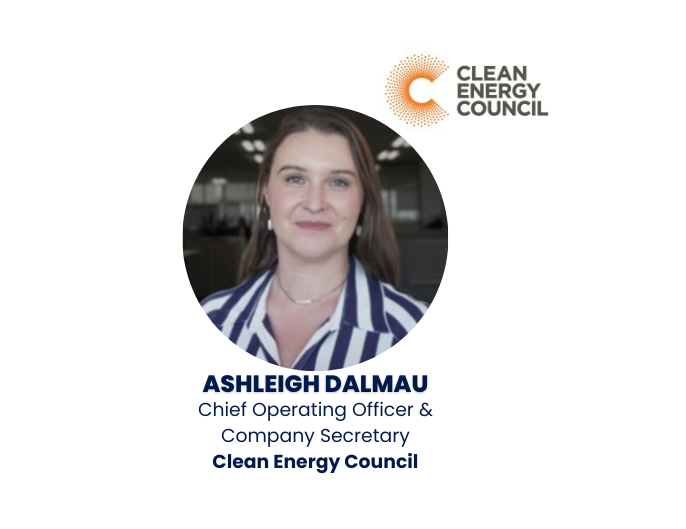Article: Breaking the circuit: Why the energy transition needs a leadership reset

The clean energy transition is rewriting Australia’s energy landscape. But if we don’t change who’s leading the charge, we’ll end up building the future on the foundations of the past.
Right now, women make up a growing share of Australia’s energy workforce, but you wouldn’t know it by looking at the top. Senior executive roles remain overwhelmingly male, despite two decades of policy push, DEI rhetoric, and shifting workforce demographics. It’s not just an equity problem. It’s a missed opportunity, especially as the sector braces for one of the most complex transformations in a generation.
In the lead up to the 2nd annual Women in Energy & Renewables Summit in Sydney, we posed this question to Ashleigh Dalmau, COO and Company Secretary at the Clean Energy Council and one of the speakers at the event. Her response was clear: Don’t just climb the ladder. Change the system.
“The system wasn’t built with these realities in mind.”
That’s how Dalmau explains the stubborn roadblock to executive leadership for women.
“While we’ve seen real progress, the biggest barrier is that women often step into executive roles right as major life events hit, such as starting a family, managing care responsibilities, or navigating transitions,” she says. “We keep trying to slot women into existing structures instead of redesigning those structures to reflect how people actually live and work today.”
That’s the crux of the problem. The current leadership pipeline assumes linear careers, 24/7 availability, and a rigid definition of what an “executive” looks and sounds like. In a sector trying to reimagine the grid, it’s time to reimagine leadership, too.
“Flexible work is a start, but we need to go deeper,” Dalmau says. “We need to challenge assumptions, shift expectations, and redesign the system so that leadership at the top reflects the diversity of talent we have throughout the pipeline.”
Hard skills get you in the room. Soft skills keep you there
If you’re an emerging leader in energy, you’ve likely heard this tension: build your technical expertise, then work on your “soft skills.” But Dalmau rejects the binary.
“It’s not either or,” she says. “The leaders who thrive, and the ones I back, are those who know their stuff and show up as real people. Technical credibility gets you in the room. Influence comes when people trust you, connect with you, and know you’re listening.”
Authenticity. Empathy. Clarity. These aren’t afterthoughts. They’re leadership assets, especially in a sector grappling with complexity, uncertainty, and the need to bring communities and teams along for the ride.
“The soft skills aren’t soft,” she adds. “They’re essential.”
Want to be an ally? Pass the mic
Progress doesn’t happen in isolation. It happens in teams, in boardrooms, and in everyday moments where someone with power makes a choice to use it differently. That’s where male allies matter, but not in the way some might think.
“Male leaders have a critical role to play as allies, sponsors, and culture shapers. But allyship isn’t just about speaking up. It’s also about knowing when to step back,” Dalmau says. “Sometimes the most powerful thing a male leader can do is pass the mic.”
This isn’t about optics. It’s about outcomes. “We fall short when we centre support around men’s perspectives. This work has to be led by women, with male leaders walking alongside.”
Emerging leaders, of any gender, should take note: the future of leadership is shared, not bestowed.
The green economy is being built now. What do we want it to look like?
Australia’s clean energy boom is more than a decarbonisation project. It’s a once-in-a-generation opportunity to build an industry from scratch, with fairness, flexibility, and equity baked in from the beginning.
But that’s not guaranteed.
“A lot of our project delivery models still mirror the construction industry, with six day weeks, rigid schedules, and narrow definitions of leadership,” Dalmau warns. “If we want different outcomes, we need different foundations. That means designing for flexibility, inclusion and sustainability from the outset, not bolting it on after the fact.”
Translation: we can’t afford to build tomorrow’s grid using yesterday’s culture. If the clean energy economy replicates the same barriers and biases, we’ll lose the very talent and innovation we need to drive it.
Breaking the circuit starts with you
If you’re rising through the ranks in the energy or renewables sector, this isn’t a waiting game. It’s a design challenge. What kind of leader do you want to be? What kind of system do you want to leave behind?
Leadership is no longer about fitting in. It’s about redesigning the space so more people can thrive. Dalmau’s message is clear: the structures aren’t set in stone. The future is still up for grabs.
But only if we build it differently.
Hear from Ashleigh and over 35 other inspirational leaders at the Women in Energy & Renewables Summit in Sydney from 9-11 September 2025. Learn more.
To access the detailed conference program, download the brochure here.
Download the Brochure


